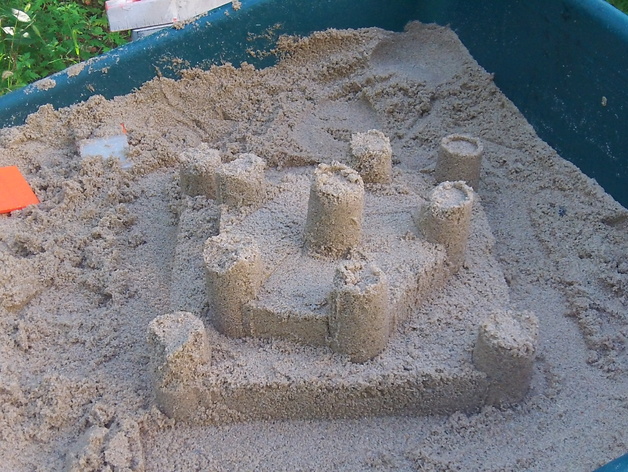
These sandcastle molds were developed by both Thomas Vagnini (portalengineer) and Kevin Kohls (pseudoeuclidean). These sandcastle molds are modular -each one interlocks with all others of the same type-, so very few molds are needed to construct a full sandcastle. You can attach the models together by sliding the connectors on the end together. There is also a hole to slide a popsicle stick in so the molds don't disconnect. However, we did not have any issue with the molds falling apart unintentionally when we built our castle. With just the tower mold (two-part assembly) and a wall mold of any length, you have the potential to build a full castle in any shape and in a variety of sizes, but the additional molds provided will give even more options for customization and stylisation. This project currently includes the following Things: Corner Tower Assembly: -Snaps to the interior angles of polygons (4, 5, 6, 8, 10, 12 sided polygons) -Connectors link with short wall segments Wall Segments: -Modular with other segments of the same height -Short and tall segments -Exponentially incremented length options: 2, 4, 8, 16, and 32cm Wall Segment Adapter: -Links to a short and a tall wall segment Golden Brick Rollers -Horizontal and vertical options The Angles: We have made our castle molds modular and versatile by making them adjustable. The corner piece can rotate to different angles between 90 and 180 degrees. To minimize the need for in-site trigonometric calculations, important angle measurements have even been marked on the sand castle mold for you. These angle measurements correlate to the interior angles of regular polygons. For example, to make a hexagonal castle, the corner must create a 120° angle; this angle is marked with a 6 (the number of sides on a hexagon). The Sides: The wall molds are adjustable as well. Instead of our original, telescoping design, we use multiple wall molds that simply interlock. With one set of linking wall segments (of lengths 2, 4, 8, 16, and 32cm), you may construct a wall of a length between 2cm and 62cm. Designing These Molds: As usually with these types of projects, we both learned how to use more advanced tools in CAD that enabled us to create better models and design more efficiently. The most difficult part of this project was the interlocking mechanism and the rotating corner. We had to prototype both multiple times to finally have a functional mechanism without any sanding or filing. Binary Walls: Using the correct combination of these sand castle wall molds to get to the correct distance is similar to counting in binary. A sand castle mold can either be used (1) or not used (0) and each sand castle mold is 2x larger than the next smallest mold. For example, to reach a length of 22cm, consider that 22 in binary is 10100; the 16-bit and the 4-bit are both 1, therefore you have to use the 16cm mold and the 4 cm mold. The Ratio: Both of us really appreciate mathematics and try our best to implement it into our designs, even if the design does not explicitly call for mathematics. We thought it would only be appropriate to implement the golden ratio in our design as much as possible. Although, you have many options when designing the layout of your sand castle, we recommend that you use pentagons, for they are the most “golden” polygon! More About The Ratio: The Golden Ratio (denoted as ?) is equal to [?(5) + 1 ]/2. Mathematicians find this famous ratio both fascinating and mysterious, because of its appearances in all brands of geometry as well as in nature. It also underlies many famous pieces of artwork, because the golden ratio is supposedly the most aesthetically appealing ratio. https://www.youtube.com/watch?v=89xH6Lln2V0&feature=youtu.beWe have designed these parts to be printed at multiple different scales and without any support material. The designs are meant to utilize the most build space of our printer but we have printed them at 50% so we can verify that the mechanisms are functional at as low as a 50% scale. We printed these parts all on Makerware’s standard settings without any support material or raft. To be more specific, the parts were printed with 200?m resolution, 10% infill, 2 outside shells, and at 230 degrees.Kevin Kohls (pseudoeuclidean)

